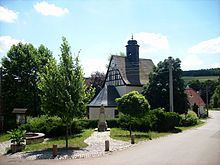Gleina (Bad Köstritz)
|
Gleina
City of Bad Köstritz
Coordinates: 50 ° 56 ′ 6 ″ N , 11 ° 59 ′ 8 ″ E
|
||
|---|---|---|
| Height : | 211 m above sea level NN | |
| Incorporation : | January 1, 1994 | |
| Postal code : | 07586 | |
| Area code : | 036605 | |
|
Location of Gleina in Thuringia |
||
Gleina is a district of Bad Köstritz in the Greiz district in Thuringia .
location
Gleina is located northwest of Bad Köstritz at the foot of the western slope to the Tautenhainer Wald not far west of the federal highway 7 in a moderately undulating terrain . In the valley the White Elster and the Gera - Leipzig railway line . To the north of the district are mining fields and heaps from the Wünschendorfer dolomite mine Caaschwitz .
In the 17th century, a "piece of wood in the Borngrund", a field called "Dienbeull" and a field "on the Eisenbergischern Steige" are named as local locations.
history
Gleina was first mentioned in a document on September 1, 1223. Until the Reformation in 1526, the place was subject to the Lausnitz monastery and was subject to compulsory payment; then he belonged to the district court of Gera in the Reuss-Gera rule , 1848–1918 to the Principality of Reuss younger line .
During the Thirty Years' War , the place was partially burned down, including the farm of the Weidlich family, which was rebuilt after 1650. This farm was a hereditary hand- hen , called "Oberes Handgut", owned by Peter Weidlich (around 1540–1608) before 1608. His son Hans Weidlich (1563 / 64–1645) took over the farm in 1609 with a severance payment to his mother and siblings of 699 guilders . His son Paul Weidlich († 1666) had to pay only 225 guilders as severance payment in 1650 because of the destroyed house, his son Christian Weidlich (1653-1715) in 1679 130 guilders. In 1709 the church was also affected by a great fire in Gleina.
In 1678 the second wife of Count Heinrich I Reuss (+ Bad Köstritz 1692), Maximiliane von Hardegg, bought the manor "Köstritz lower part", which was largely destroyed by fire in 1675, for 27,000 thalers from the family v. Wolframsdorf ; this also included "the church fiefs with subjects of Gleina". In 1687 Count Heinrich I formed a Fideikommiß from these and other estates in the Vogtland , from which the Paragium Reuss-Köstritz emerged in 1692 . Associated with this were the patronage rights for the filling of parish and school posts as well as the supervision of them. According to the church book, there was a "Michael Schulmeister in Gleina" in 1719.
Eleonora v. Promnitz, widow of Heinrich XXIV. Von Reuss-Köstritz , acquired in 1758 with the manors to Köstritz "the middle and upper part with their outworks and some subjects in Gleina." by August Wilhelm v. Wolframsdorf; these goods were also added to the Paragium Reuss-Köstritz in 1776.
Until it was incorporated into Bad Köstritz on June 1, 1994, Gleina was an independent municipality.
Attractions
The church at Gleina was probably built around 1220 to 1250 as a Romanesque chapel. When the windows were enlarged after the Reformation, the interior got more light. In 1785 the organ builder Christian Friedrich Poppe from Roda built a valuable late baroque organ there, which originally came from the palace chapel in Köstritz. In 1801 it was rebuilt in its current form and equipped with a cross altar, order of the women's chairs and the gallery. In 1932 and 1986 the church was restored by painting.
In the small church tower hangs a bell from 1764, cast by Heinrich Friedrich Wärkherr zu Gera, with the inscription of the patroness of the church: "Maria Eleonora Emilia, widowed Reussin, countess and mistress of Plauen, née Freyin v. Promnitz, and Heinrich VI . Younger Count Reuss and Mr. von Plauen. After six anxious years of war, God lets us experience a lot of good. " A second, smaller bell from 1815 no longer exists today.
Individual evidence
- ↑ Wolfgang Huschke: On the origin of Wilhelm Weitlings , in: Genealogie, Bd. 9, 17th year 1968.
- ^ Wolfgang Kahl : First mention of Thuringian towns and villages. A manual. Rockstuhl Verlag, Bad Langensalza, 2010, ISBN 978-3-86777-202-0 , p. 91.
- ↑ Wolfgang Huschke: On the origin of Wilhelm Weitlings , in: Genealogie, Vol. 9, 17th year 1968, pp. 1-9.
- ↑ Showcase at the church in Gleina, April 25, 2017.
- ↑ Friedrich Wilhelm Trebge: Tracks in the country. From the history of the apanaged Thuringian-Vogtland noble house Reuss-Köstritz . 2nd edition Hohenleuben 2005. pp. 42–44.
- ↑ Trebge: Tracks in the country . Pp. 46-47.
- ↑ Henry VI. (1707-1783), Count Reuss zu Köstritz older branch, was a son of Heinrich XXIV. Count Reuss von Schleiz zu Köstrotz , founder of the Reuss Paragiats Reuss-Köstritz and his wife Eleonora v. Promnitz -Dittersbach (1688-1776).
- ↑ Showcase at the church in Gleina, April 25, 2017.



